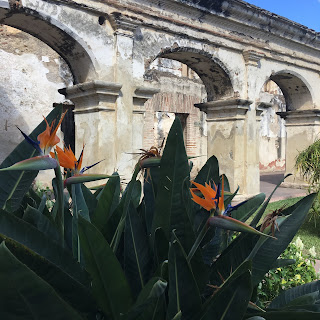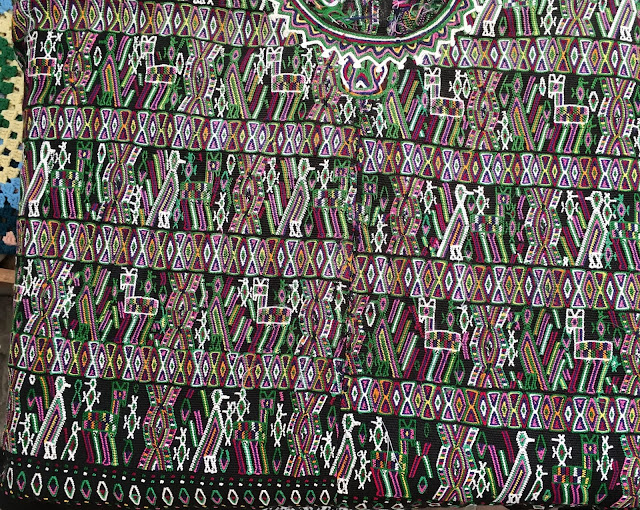 |
| Ruins of Santa Clara convent; birds-of-paradise in foreground |
 |
| La Merced Church in Antigua, one of several examples of wedding-cake style Baroque architecture. This church is still in use. |
 |
| Sunset on Lake Atitlan from Panajachel |
 |
| Adelaida demonstrating spinning cotton |
 |
| Jessica, foreground, and Christina, background. Wearing traditional traje doesn't mean you don't use a cell phone! |
 |
| Look, ma! I'm weaving! |
 |
| The view from the loom. |
Weavers say that "it's not the loom, it's the weaver" that determines the quality of the final product, and the backstrap loom makes that abundantly clear. We got to bring our looms home with us, and I look forward to finishing up the indigo ikat scarf on mine. My selvedges leave a lot to be desired, but I'm going to wear that scarf!
There were a number of woven pieces in the workshop that I had to bring home. The intricacy of this indigo ikat (called jaspe here) entranced me. The whole piece is large enough to cover a queen bed, three widths decoratively seamed together.
I'm not sure how I'll use this piece of green brocade fabric but I knew I couldn't live without it.
Much of our week involved visiting various markets. We went to Central America's largest market, in Chichicastenango, and I was able to find small amounts of hand-dyed cotton-blend yarns.
There was also a stall selling loom parts and other wooden weaving tools, where I bought these combs.
 |
| Note the new double-ikat pants I'm wearing. A practical purchase! |
The best bargains of the week were found in the Los Bomberos market in Sololá, a flea market of used huipiles, cortes and other items. There I purchased probably my favorite pieces: these two huipiles and this jaspe corte, pictured at bottom. This green fabric is sewn into a tube that would be worn as a skirt, cinched around the waist.
During my long trip home, I kept sneaking peeks at these treasures, pulling them out to study the patterns and try to determine how the weaving was done (the huipiles are a type of brocade). The more I looked, the more I saw. I felt as if I were trying to read an epic poem in the original Greek, or in this case, one of the 22 Maya languages. These works and others like them represent, thanks to the skill of generations of weavers and dyers, a monumental achievement in color, pattern, and beauty. The city of Antigua is designated a UNESCO World Heritage Site; it seems to me that Guatemalan weaving deserves similar recognition as a priceless human cultural treasure.
Since I returned, I find myself wondering about how color is connected to place and to culture. I am familiar with the basics of color theory and harmony and I have books that can tell me about the history and use of this or that color or dye. But I wonder, is it true that color use in tropical climates, for example, tends to be more bright and unrestrained than that in northern climates? Why? Of course colors are influenced by the local natural dyestuffs available. I saw vivid colors in naturally-dyed cottons in Guatemala that put the lie to the conventional wisdom that natural dyes are more subdued than synthetic dyes. I know that I will continue to research questions of color, place and culture, and the history of Guatemalan textiles.
I'm not sure yet how this trip will impact my own work. I can say that when I arrived home, my own tapestries in progress looked pale in comparison to my Guatemalan treasures!









4 comments:
What gorgeous fabrics! I can't imagine how anyone could sleep after seeing so many glorious colors and patterns. Your head must have been spinning!
Lynn, I think my head is still spinning a bit! (I replied to your comment the day you made it but I don’t see it, so here it is again. )
Loved reading this blog post...all of the memories of my trip in 1994 came rushing back...the riot of color, smells, lovely lovely people. I am so happy to have connected with Spanglish Fabrics as my go to source of Guatemalan textiles ( my original collection is long gone...now in the form of wearables).
I look forward to following your blog..
Cindy Cook-Keller
CynthiAnDesigns
Thanks for reading, CynthiAn! Glad to hear this post brought back happy memories.
Post a Comment